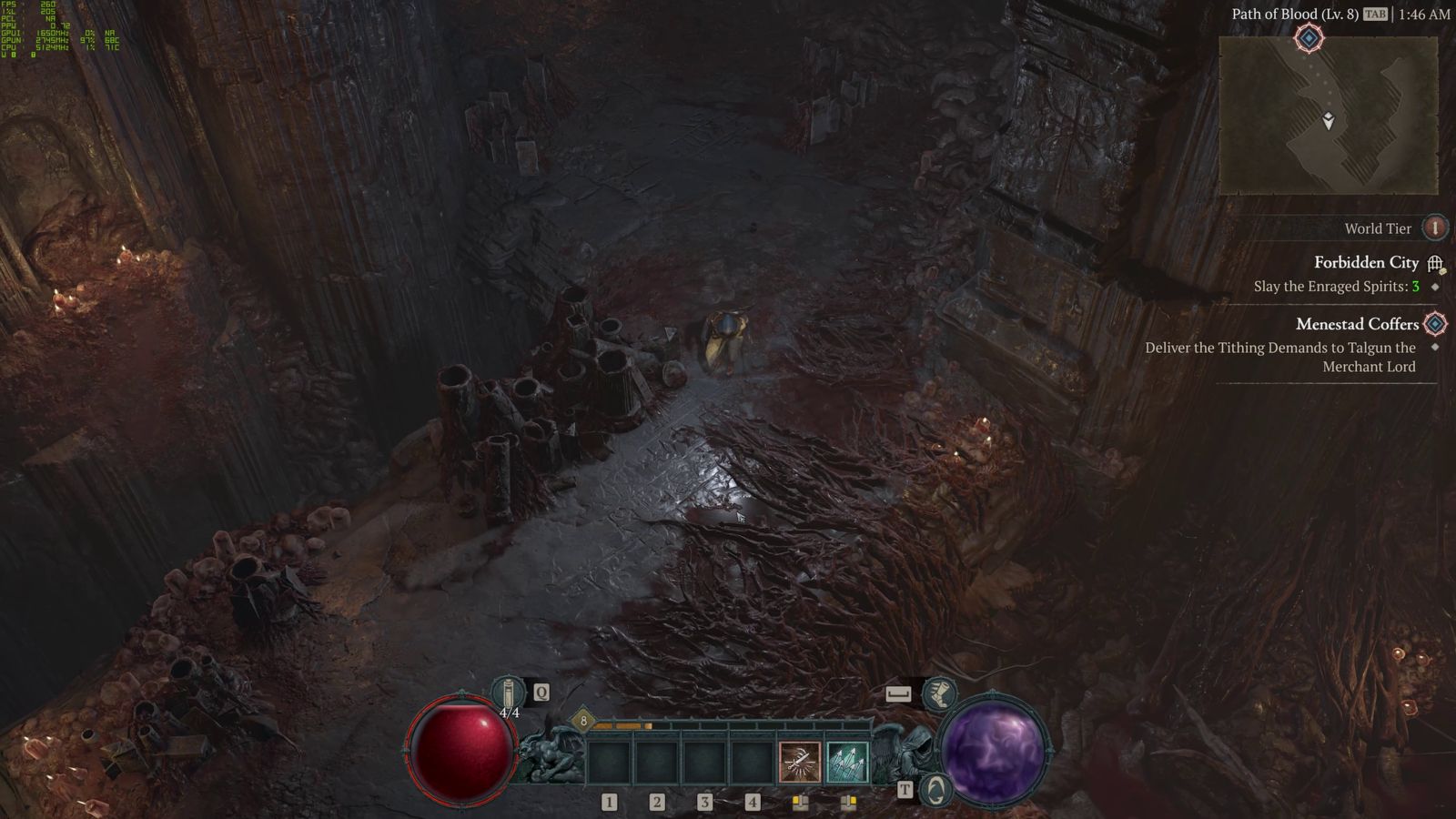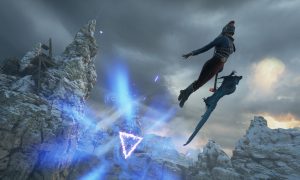Diablo IV is a challenge to review. While its predecessors have been fairly straightforward affairs, with a linear story and builds that are more dependent on gear drops and loot tables, Diablo IV has a veritable cornucopia of options that are even more plentiful than I could have imagined. Frankly, it has very little to do with the previous games beyond the lore and some story threads. As such, we’ll be focusing almost exclusively on game systems, classes, where the game is at launch, where it’s expected to go, and the true potential of Diablo IV. This is going to be one heck of a long review, but thankfully I brought with me three more adventurers. Stay a while and listen while the Gaming Trend team gives you the low-down on Diablo IV.
My team has had access to Diablo IV for a significant amount of time prior to launch. We’ve all participated in the various betas, as well as the server slam, and now we’ve had several weeks of unfettered access to the final build of the game. As such, we are fairly confident in our assessment of the title. While server wobbles could happen, the last two free-for-all events were frankly so smooth that it should be a case study for anyone launching a live services game in the future – truly a marvel in the modern gaming age.
And yes – Diablo IV, at its very core, is a live services title. What’s beautiful about it, however, is that somehow the team has managed to build a game that works solo, paired, as a team of four, and even partnered up with a whole group to take out a world boss. It does mean that the game requires an always-on connection, so know that going in. There are advantages and disadvantages to this approach that we’ll discuss as we go.
Despite being an always-on game, Diablo IV has a complete and cohesive storyline with a beginning, middle, and end, not unlike a traditional offline title. As such, we’ll be focused on the mechanics of the game more than the story threads – we don’t spoil the story around here. That said, there is a little bit of setup you should know.
The game kicks off fifty years after the events of Diablo III: Reaper of Souls. The war between the Burning Hells and High Heavens (better known as the “Eternal Conflict”) has spilled over, slaughtering humans, demons, and angels alike. The people of Sanctuary have suffered, and mankind is at their lowest point. When all seems lost, Lilith, the Daughter of Hatred and mother of Sanctuary returns to her creation, enthralling everyone in her wake. Unfortunately, this applies to you as well, having crossed her path in the opening moments of the game, leading you to chase her across the massive world of Sanctuary to stop her inevitable rise to power and the start of a brand new dark age that could consume mankind once and for all.
If it’s a concern, let me assure you, Diablo IV is not only dark, but downright cruelly so at times. Gothic, bloody, vicious, and brutal barely even covers it. Eldritch horrors abound, as do dead bodies, disembodied corpses, and far worse that I won’t spoil for you, giving Diablo IV more of an aesthetic and color palette in common with dark Renaissance paintings than its predecessor.

Before we go any further, let’s talk about Lilith for a second. No, I’m not about to launch into a major spoiler here, but I do want to talk in broad terms about the bad guys of Diablo IV. Diablo has always been a world of gray areas, where even the good guys are doing some fairly dark things in service of the light. That has only deepened in Diablo IV. Here, however, the bad guys rarely hide below the world’s veneer, instead standing bright and bold, right up front. Lilith isn’t shy, making many appearances in the game. Various other characters you meet are equally as bold. The way Blizzard approached in-engine cinematics has enabled this, and the story benefits greatly from it. It also means that they can introduce new elements and story threads without the need to spend an extensive amount of time and money on expensive CGI.
Without spoiling the story I’ll say that it is a dark and brooding medieval experience. Lilith is the mother of Sanctuary, and the angel Inarius is its father. If you think that’s a clear cut line between good and evil, you are in for a rollercoaster of a storyline. It’s easy to start seeing Lilith’s point as the events of Diablo IV unfold. I’ll say no more on the subject beyond the fact that it has a clear beginning, middle, and end, and that’s magnificently told in true Blizzard fashion.
At launch there are five character classes – Barbarian, Druid, Necromancer, Rogue, and Sorcerer. We’ll talk about them as archetypes, but with the way that skills are now selected to create wildly different versions of each, it might not be fair to sum them up too much, but let’s get an overview.
The Barbarian is your tank of the group, equipping four weapons. Dual wielding just about any weapon, they also carry a massive maul or something similar, as well as a spear or large sword. It’s a lot to carry, but the Barbarian is up to the task, being the largest and most physically formidable class. They can unleash shouts to demoralize the enemy, bolster your own crew, and stun creatures in their tracks. They can also slam the ground or leap into the midst of a crowd to stun everyone around them. All of their skills revolve around raw strength, brutalizing foes where they stand.
The second largest character type, physically, is the Druid. This is the first time we’ve seen them since their appearance in Diablo II, and they bring with them some vicious new abilities. Able to transform into a vicious werewolf or a massive lumbering bear, they can claw, bite, and thrash their opponents with reckless abandon. They can also summon companions like wolves, vines, and ravens, as well as unleashing elemental powers to fill a role between front line fighter and mid-range harasser.
Necromancers are all about waking the dead. Wielding the power of death, they can raise armies of undead creatures from the corpses in the battlefield, unleashing them on the once-allied monsters. Splitting their powers between bone, blood, and shadow, Necromancers power their grotesque craft with corpses and essence. Not unlike mana, this resource fills with basic skills and talents, but it’s the bodies of the dead that is their greatest asset. Bringing them back to life as skeletons or even a golem, they can also further sacrifice them, causing them to explode, poison the area, and more.
It’s awesome to see the Rogue return — we’ve not seen rogues since the original Diablo. They are all about speed, utilizing daggers, shortswords, and massive bursts of speed. After they level up a bit, they add various augments like poison or fire, as well as traps and stealth. A bit of an amalgamation of Diablo II’s Assassin and Diablo III’s Demon Hunter, the Rogue is a blur of damage and death.
The Sorceress is a staple of the franchise, albeit with occasionally different names. While they are affectionately (or objectively, when a specific skill is selected) called a “Glass Cannon”, unable to take much damage up close, they are able to dish it out in a wide variety of ways. Ice, fire, shadow, lightning, little angry hydra heads that spew fireballs — they are spoiled for choice for their mastery of the elements, albeit at a distance.
If you look at prior entries in the series, there are plenty of opportunities for expansion. In prior games you could play as an Amazon, Warrior, Paladin, Demon Hunter, Crusader, Assassin, Monk, Witch Doctor, and Wizard, meaning Blizzard has a massive amount of potential to expand on this already huge game.
Taking Diablo III for example, any of the characters would start out relatively similarly. You’ll unlock each power in sequence, meaning a level 10 Crusader from column A is the same as another one in column B. Here, they couldn’t be more different. By way of example, I made a Barbarian without a single berserk power – not a single one. Instead I focused on stunning, dual wielding, and crowd control. I could have also focused on literally any of the 45 skills and smaller upgrades that can completely transform the way your character handles battle. As another example, a sorcerer could go very wide, carrying all four elements into battle. Or they could go very deep, dishing out a wide variety of lightning effects, rendering them into a spear, a ball that drifts along and kills as it moves, or chain lightning that jumps between anyone it touches. The important part here is that the choice is entirely yours. You can also respec early skills relatively cheaply, refactoring your entire character at a marginal cost.
When you hit roughly level 25 (every journey is different, remember), you’ll have enough skill points allocated to select an ultimate. These are massive advantages in the battlefield, with long cooldown times and devastating results. The rogue, for example, can duplicate himself with a shadow version, doing 60% of your base damage, or even 80% if upgraded. It even doubles your special attacks and traps, making it an extraordinary power. They can also choose a vicious death trap that does over 1400 points of damage to anyone foolish enough to step on it, or pulling them in like a vortex with another point of improvement. The final rogue skill is a familiar one – Rain of Arrows. Unleashing a storm of barbed death from the sky, the rogue will pepper an area with hundreds of arrows, with knockdown being their improved function. Don’t think this is the end of your skill tree either – five passive skills await you in the final branch of your tree.
The other classes have their own Ultimate abilities as well. The Druid class can unleash lightning storms, increase Fortify from all sources, rage out in their Dire Werebear or Supreme Grizzly forms, or petrify all nearby enemies. Sorcerers can freeze enemies in place until they explode, unleash a massive inferno, or rip lightning through the space with double casting. We could go on and on about this for ages, but it’s more fun if we let you discover the rest for yourself.
Beyond your Skill Tree, and gated behind Level 50, are Paragon levels. The Paragon system isn’t a new thing, but it’s a night and day difference from what we had in Diablo III. The Paragon board is a massive cluster of nodes broken into Normal, Magical, Rare, Legendary, and Glyphs. Each of these serves as building blocks to build your main stats (Strength, Intelligence, Willpower, and Dexterity) but also has more advanced rewards if you meet the criteria.
Moving around the board you’ll encounter higher rarity nodes. These may have prerequisites such as having a certain amount of strength or intelligence to proceed. These act as gateways to the other nodes in the board, pushing more powerful nodes like a boost to life or critical hit percentages.
When you finally reach rare nodes you’ll begin to see more substantial nodes. As before, you’ll have prerequisites, and if you fail to meet them, you’ll receive only half the reward.
Further into the node pool you’ll find Legendary Nodes that provide major improvements to your skills, usually aligned with a specific play style. This could be poison aspects, or additional damage for your mage golems and the like.
The final node type is a Glyph. Glyphs are superpowered nodes that typically offer up a handful of upgrades to stats and attributes, meaning you can end up adding hundreds of points of power. Exploiting all of these nodes can result in a super-powered monster of a character.
Admittedly, we didn’t get to spend a great deal of time with this new system. There’s an embarrassment of possibilities here, continuing the specializations well past the end of the storyline. Further testing on this is needed, but what we’ve seen thus far should give Diablo IV legs well beyond any of its predecessors.
Once you reach the hub city of Kyovashad you can adjust your World Tier, the game’s difficulty. At a statue in the middle of town you’ll pick between Tier 1 and 2 which adjusts several levers to amp the experience. At Tier 1, the default, enemies are easier to defeat. It’s meant to provide the base experience and will let you enjoy the story. Tier 2 is also available from the start, pumping up enemy difficulty, but providing 15% more gold and 20% additional XP. In personal experience, it also nudges the loot table up a notch, though that could be anecdotal. Tier 2 provides the best balance between your gameplay experience and the story. Once you hit level 50 you can unlock Tier 3, appropriately dubbed Nightmare Mode, and enter the endgame.
Nightmare Mode requires that you complete a capstone dungeon called “Cathedral of Light”. It’s here that you’ll find Sacred and Unique items, as well as Nightmare Sigils that can be used to unseal Nightmare Dungeons. Helltides also start to appear across Sanctuary, which are regular events where the servants of Lilith are even more powerful, however conquering them is well worth the fight as you’ll earn valuable Helltide Chest loot. You’ll also start running into Champion versions of monsters that carry various auras. For your pain you’ll gain 100% more XP and another 15% more gold.
Tier 4 is called Torment, and by the description it’s aptly named. Reserved for level 70 and above, this too will require another capstone dungeon called “Fallen Temple”. You’ll get 200% more XP, and another 15% more gold. “Ancestral items” and additional uniques lie in this tier, though we haven’t unlocked these for ourselves quite yet.
As you wander the world you’ll occasionally see an orange circle on the minimap. Entering these circles will often reveal some ritual or bad stuff that begs for you to stop it. Smaller monsters may be charging up a larger one, or they might be summoning spirits, or any number of things. A stranded party might need your help as they fend off an array of monsters, or it might be a caravan under siege that needs you to defend them from incoming enemies. It can also be four ancient obelisks that require that you slay monsters near them to offer them blood. From my estimation there are a shade over a dozen or so, but this is an area where Blizzard can subtly add without too much effort, meaning these could change over time.
Occasionally you’ll run into moments where you don’t see the event coming. You reach over to pop the lock on a box and suddenly you find yourself defending against a massive influx of beasts intent on eating your liver.
All of these events can be completed for a reward of some kind, but each offers some additional bonus goodies should you do so “with mastery”. This can mean dispatching foes in a certain amount of time, or taking out supports before a ritual is complete. Completing an event with mastery means you’ll often get far better gear as a reward.
Speaking of monsters intent on eating you, there are several world bosses that spawn periodically. These require an entire crew to dispatch, allowing a crew of up to 20 to face off against the otherwise insurmountable odds. These creatures require preparation, gear, knowledge, and a dash of luck, so plan accordingly. World bosses tend to drop excellent gear and materials that work for people interested in min/maxing builds, and it’s extraordinarily satisfying to take them down. Everyone is doing their part to yield victory and even if you die, you can spawn back, you just have to be aware of your gear breaking. It’s fun, it’s useful, and it will test you.
Diablo IV is, by design, a cooperative experience. That said, the scaling systems in the game allow for solo play. You can party up with up to three additional players for a team of four, but there’s some special Blizzard magic going on behind the scenes.
As this is a shared open world, Blizzard wants players of all levels to be able to play together. When a team enters a dungeon, the level 20 character will see and face level 20 enemies, but when the level 52 character sees those same enemies, they are level 52. Similarly, since the loot is instanced to each player, it’s also scaled appropriately. It means everyone has a challenging experience and appropriate rewards.
There are also areas that have a level floor, meaning a minimum level to engage effectively. For example, the Stronghold for Kor Dragan has a level floor of 25, so assault that below level 25 at your own peril.
World Events are a variant as they don’t require that players be in a group to join them. There doesn’t seem to be any limit to the number of players that can join a World Event, though if the World Boss events are any indication, that cap is 20.
Below you’ll find a spoiler free run with the four of us completing a side dungeon. It’ll showcase four distinct classes, as well as how well the world leveling system works. Enjoy!
However, getting a group of friends together to play can be a challenge. Life gets in the way, and maybe not everyone is available to play at the same time. Gathering up a group of folks who all want to play the same way (e.g. casual, XP farming, world boss running, etc.) is good enough reason to clan up and gather under one banner.
Clans in Diablo IV, at least at launch, are little more than a way to assemble easily. You can see clan members come online, grabbing achievements, and engaging with the world, but beyond that it’s a glorified list. Sure, you can share a banner that you’ve designed, and you can designate various ranks to differentiate your Officers and such, but to little effect at this point. I’m hoping there is more to be done here post-launch. Perhaps a marginal boost to people who are clanned up, and some way for clans to rank up their standing as well. It’s a gap at present, but one that would be easy to shore up later.
Dotted around the landscape you’ll find various dungeons. Hovering over them you’ll see that they have a Codex of Power that you can acquire if you clear them. Plumbing the depth, you’ll often face hordes of enemies, followed by a boss fight. If you win the day, these Codex of Power rewards can be affixed to your equipment, for a cost, of course. This might transform how a power works completely, striking in a circle instead of linearly. They can also be a direct bonus to various skills, such as granting a certain amount of essence after a corpse decomposes. There are 115 of these, and their rewards are unlocked account-wide, so you won’t need to re-run these dungeons unless you want to.
I’m happy to report that these dungeons feel like they were hand built. Random elements and scenarios pop up to keep them fresh, so if you do happen to re-run them you’ll probably have a slightly different experience each time.
These dungeons aren’t tiny, either. I was having a “Just one more dungeon” moment and thought I’d run another one before bed. Well, it was a late night that night as that dungeon ended up taking about an hour to complete. Each of these dungeons is punctuated by a boss, and that’s the only problem I had with them – I’ve seen a few bosses with minor variants a few times. It’d be nice to see these swapped out for bespoke challenges at the end of the fight.
As we mentioned before, at higher World Tiers you’ll begin to find Nightmare Sigils. These unlock specific dungeons, called Nightmare Dungeons, somewhere within Sanctuary. Each sigil will heavily modify the dungeon with various affixes to make them match their namesake. Based on various discussions by the Blizzard team, these will unleash more powerful versions of the various affixes you’ll find elsewhere such as lightning bursts, explosive monsters, and worse. You’ll also occasionally open Hellgates which will pour armies of monsters all throughout the dungeon, making already difficult areas even harder. When you complete one of these dungeons, you’ll also find additional Nightmare Sigils, each of which is purported to add additional difficulty and mutations to gameplay.
Strongholds can be found throughout Sanctuary that can be restored, returning that area to its former glory, liberating it and giving it back to the people. These will turn into minor settlements and towns, allowing players to find respite here to repair their equipment, sell their goods, and rest up. None of them will have all the services a major city like Kyovoshad will have, but they can be a good waypoint just the same.
At present, we are only aware of three Strongholds – Malnok at the center of the Fractured Peaks, Kor Dragan in the north above Menestad, and Norstrava to the west of Kyovashad. Undoubtedly, Blizzard could add more as the map opens up with expansions, but I’m surprised to only see these three. They do offer a bit of an oasis in the desert, so to speak, but this feels like an area where Blizzard had a good idea but didn’t push it as hard as others.
Honestly I could spend the length of this review and more on the loot in Diablo IV. Diablo IV’s loot system is loosely based on their previous efforts, but layer upon layer of complexity have been subtly laid over the top. Intricately woven into the skill system, loot now serves to build your character into something more purpose driven. As such, you won’t have hunts for “Godly Plate of the Whale”, instead more focused on specific affixes in service of your current build. Since that build can be wildly different from anyone else, it makes farming a bit different.
Each class is made up of a few different choices, and the attributes of your class. For example, a Sorceress might specialize in lightning, with a focus on intelligence. As the affix modifiers on equipment and their values are randomized, even finding two versions of the same piece of gear will likely yield wildly different equipment and outcomes. One might provide an additional 50 points of damage of one type, while the other offers none, instead giving a boost to minion damage.
The loot system still follows the tried and true color system, from vendor trash to Unique, but adding Sacred and Ancient item types for endgame fun.
You might be thinking “oh great, now I have to farm until I find precisely the right combination”, but rest assured, dear reader, that is not the case. By visiting an Occultist, you can destroy an item to absorb various aspects. This will allow you to imprint that aspect onto another Legendary or better item. It’s the Mr. Potato Head of loot modifiers, but it works well. These aspects are single use, so that’s where your farming will come in if you want to stack specific affixes.
The various affixes you unlock by clearing the Codex of Power dungeons are permanent, meaning you can assign them at the Occultist any time and as often as you wish, for a price of course.
Part of collecting loot is that you’ll end up with gear that’d be better suited for your other characters. The storage box returns, and it’s shared across your entire account. Thankfully there are new ways to organize it, including designating them with symbols like armor and gems. As before, you’ll be combining gem and skull types to make better ones, so expect a whole jewelry store to take up at least some of your space.
Leveling up is the awkward teen years for your gear. You’ve got a cool hat, but the rest of your equipment makes you look like a recent graduate from clown college. Well, no longer! Dragging equipment back to the Smith, you can deconstruct said equipment to learn how to transmogrify the same class of equipment to look like that one. A huge shout out to the Blizzard art team as, even when mismatched, they’ve made some incredible equipment. What’s better still is that, like skills, it makes each character unique.
Potions operate a little bit differently than they did in previous games. You can only carry a certain amount of them, only this time they don’t take up precious inventory space. At the start of the game you can carry four of them, but at level 10 you can visit a vendor who will, as long as you have the coin and right materials, allow you to carry one more and bump up their effectiveness. You’ll find this upgrade available every 10 levels, so plan accordingly.
Each class also has a passive ability or unlockable skill that will give them marginal health recovery, such as the Rogue’s Siphoning Strike skill, which gives you 1%-3% health with each critical strike, and the Necromancer’s ability to recover small amounts of health by picking up death orbs from fallen enemies (think Reaper from the early Overwatch days). These skills and abilities aren’t exactly life sustaining, but may come in clutch just enough to keep you in the fight.
Elixirs are a game changer, but they are also very easy to ignore in the beginning. As you explore Sanctuary you’ll find various bushes and plants that can be harvested. Combining these you’ll be able to make elixirs that provide massive bonuses for a period of time. Tough bosses suddenly turn into an even fight with the help of elixirs, so having them handy (and remembering to use them) can swing the fight in your favor.
Challenges were something introduced in Diablo III, and that tradition continues here. Throughout the game you’ll have a number of challenges you can undertake. Some of them are simple, such as killing 15 enemies in under 5 seconds. Some of them are a bit more convoluted, requiring a bit more forethought, such as killing 200 enemies while in werebear form, and while also infected with rabies. There are 473 of these in all, but there is nothing to stop Blizzard from growing this list indefinitely as more content is added. Like collections, these are also account-wide.
While you are out completing collections and challenges, you’ll also find Altars of Lilith throughout the world. These provide an account-wide bonus to any characters in that region, and frankly are somewhat challenging to spot, despite being right out in the open and glowing!
There are a great many quality of life upgrades that Diablo IV brings to the table that I’ve come to appreciate a great deal. For example, when you complete a dungeon you’ll see a green checkmark to let you know it’s complete. Similarly, if you pin a destination on the map, those in your party can see it and it’ll give you a path on your minimap to reach it. Once you complete a dungeon, you can select “Leave Dungeon” to, you guessed it, leave the dungeon rather than trekking back to the entrance. Icons appear over your hotbar to let you know when you are near another player to gather up that sweet 5% bonus XP, which grows to 10% when you are near your party members. Day and night cycles, as well as dynamic weather, makes the world feel alive as it won’t always be sunny and dry when you visit a specific region.
The biggest quality of life improvement is the cinematics system. In previous games you had to rely on expensive CGI to bring the game to life. While there are some CGI cutscenes, most of the game is told with in-engine cinematics. Before you groan, the models in this game were built with that end in mind, meaning every character was modeled at a level of detail that exceeds any expectations you might have had.
As you accomplish specific tasks you’ll also unlock titles. These are pure fun, but it gives you a massive amount of tags you can have appear over your head. It’s a prefix/suffix sort of situation, and it doesn’t have to be taken seriously, leading to my character’s designation as “Likely Trash”. It’s a fun addition that adds a bit of personality to the game.
Diablo IV is also fairly accessible and easy to get into for new players. Some of our crew are still a little green when it comes to Diablo. The two different World Tiers available at the start of the game made it easy to jump right in, and there’s nothing particularly complicated about the combat system, including learning button assignments, something that can feel rather daunting to newcomers. While there is a lot of depth, you’re able to play at your own pace, giving you plenty of time to learn and master your craft.
There are some bugs left in Diablo IV at launch that hopefully will be shored up in short order. On an RTX 4090 I’m getting jumps from 300+ fps to 120fps without rhyme or reason. On the flip side, I didn’t see that same problem occur on my RTX 2080 Super-equipped laptop, which suggests it might be driver related. I also can’t set full screen, meaning it’s very easy to scroll right off your screen if you have multiple monitors. It also means you can’t set your refresh rate, which is guaranteed to lead to screen tearing.
Aside from technical issues, there are some design choices that can be frustrating. There’s a need for a button to highlight all of the interactive elements such as loot and levers. Without it, it’s very possible to miss a progression element, meaning you’ll spend a bunch of time wandering around an already-cleared level.
While we have experienced the story for the game, and even with all we’ve revealed thus far in our review, there’s still a wealth of gameplay beyond that we simply did not have enough time to explore. You’ll have undoubtedly noticed how scarce some details may be, however, rest assured, there will be numerous secrets, challenges, and content that appears after the credits roll for the first time, and we’ll have to wait until we have a lot more time with the game than the last few weeks. There is a lot of depth to Diablo IV, and as such, we’ll be doing periodic updates over time as we discover new ways to play. Stay tuned – we are just scratching the surface.
Ron Burke is the Editor in Chief for Gaming Trend. Currently living in Fort Worth, Texas, Ron is an old-school gamer who enjoys CRPGs, action/adventure, platformers, music games, and has recently gotten into tabletop gaming.
Ron is also a fourth degree black belt, with a Master's rank in Matsumura Seito Shōrin-ryū, Moo Duk Kwan Tang Soo Do, Universal Tang Soo Do Alliance, and International Tang Soo Do Federation. He also holds ranks in several other styles in his search to be a well-rounded fighter.
Ron has been married to Gaming Trend Editor, Laura Burke, for 28 years. They have three dogs - Pazuzu (Irish Terrier), Atë, and Calliope (both Australian Kelpie/Pit Bull mixes), and an Axolotl named Dagon!
Cassie Peterson is an Editor for Gaming Trend but also a sporadic content creator and exceedingly average Rainbow Six Siege player. She goes by MzPanik on Twitter and Twitch and all of the gaming platforms.
Anthony Shelton hosts and produces the Gaming Trend podcast and creates opinion videos occasionally on YouTube. He carries some of the strongest opinions among the staff and is generally harder to impress. But if impressed, he sings developers' praises just as loudly. He typically plays everything except horror and most RTS, but genres he gravitates towards are platformers, FPS, racing, roguelikes, fighting, and loot-based games. He has quit Twitter and uses Threads. Follow him at iamashelton.

Diablo IV represents a massive shift for the series, moving to a more inclusive and open world that is somehow as inviting for new players as returning veterans. Complexity is mixed with flexibility to create a game that is sure to consume you for hundreds if not thousands of hours. Diablo IV is the game we’ve been waiting for, and a return to form for the Blizzard team.
PROS
- Hell has never looked so gorgeous
- Auditory feast, from music to monsters
- Shades of gray storyline is satisfying
- Infinite extensibility beyond the end credits
- There’s still SO much more to discover…
CONS
- There are only 24 hours in the day…
See below for our list of partners and affiliates:


























